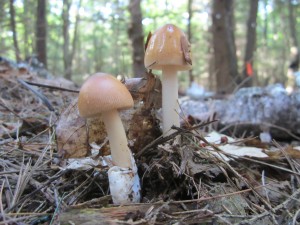How a Common Fungus Is Protecting the Earth from a Climate Change Nightmare

Photo Courtesy of Colin Averill
Just a couple of the many fungi that UT PhD student Colin Averill encounters in his work.
There is more carbon dioxide stored in the ground than in the air around us. If those all that greenhouse gas escapes, it could be catastrophic for the earth. Now, a researcher at the University of Texas at Austin thinks he’s found the key that keeps much of it locked away.
It’s research that could revolutionize how we understands climate change, and potentially help us combat it, and it all has to do with a feast happening just under your feet.
Colin Averill, a PhD student in the program of Ecology Evolution and Behavior at UT Austin, says there are a handful of creatures partaking in that feast, and their competition for food regulates the flow of carbon dioxide between the soil and the atmosphere.
First, the Eaters:
Averill’s research looks at the way plants, trees, fungus and “decomposer microbes” all battle for a seat at the dinner table.
The microbes “make a living breaking down dead stuff,” Averill says.
“So, they sit in the soil and they produce enzymes that break down tree branches or leaves, and they take up those smaller molecules and they use them to grow.”
Trees, plants and fungus also need that decomposing stuff. Just like fertilizer, it’s rich in nutrients. It’s also rich in carbon. That’s carbon dioxide that plants have taken out of the atmosphere when they were alive. Now it’s locked in the dead leaves and branches in the soil.
“If you were to release all of the carbon that’s in soils and put it in the atmosphere, the atmospheric concentration of carbon dioxide would double or triple,” Adrien Finzi, a professor with the Department of Biology at Boston University who worked with Averil, says.
But a lot of that carbon dioxide is released and then cycles back in. The transfer of carbon dioxide from soil into the air is generally balanced out by trees and plants that breathe the carbon dioxide back out of the air and return it to the soil. Scientists call the process “carbon cycling.”
But there are parts of the world were more carbon dioxide stays underground. Researchers have always thought it was weather-related, but Averill’s research suggests maybe it’s not. Maybe it’s the fungus.
A Mercenary Fungus
It turns out that in these parts of the world – generally colder parts – a certain kind of fungus is prevalent. It’s a group called ecto and ericoid mycorrhizal fungi.
These fungi form a symbiotic relationship with certain trees and plants to help them access underground nutrients. These are tough fungi.
“They’re basically a mercenary for the plant. They basically rip nutrients out of the organic matter and pass it to the plant,” says Averill.
That means there’s less food for those decomposer microbes. That slows the microbes down. Since they are less active, they stop pumping as much carbon dioxide back into the air.
If the research is correct, it shows us the key that locks carbon underground. And it begs the question: could this special fungi be used to keep more carbon dioxide locked down?
“Definitely,” says Adrien Finzi. “Maybe. Yes.”
But, Really, No.
While Finzi says he doesn’t want to underestimate the powers of human ingenuity, the likelihood of somehow encouraging fungi growth to counteract climate change is far-fetched.
“The idea that you could maybe sprinkle the spores of some of these ecto and ericoid mycorrhizal fungi across the earth’s surface,” Finzi says, “and hope that they associate with the right plants, and then all of a suddenly decomposition rates go down, and we sort of cap more carbon into the earth is pretty hard to imagine.”

Photo from Hawks Lab: www.sbs.utexas.edu/hawkeslab
Colin Averill studies in the Biology Department at UT Austin. He's researching the impacts of fungi on climate change.
He says it’s easier to imagine a more frightening scenario in the other direction.
As the earth warms due to climate change, that could encourage more decomposer microbes, and that could unlock more carbon that would cause more warming. That could encourage more microbes which would unlock more carbon, and on and on in a self-perpetuating cycle of warming.
“One fun fact is that the concentration of carbon dioxide that is projected for later this century or maybe 2100 will be higher than it’s been in the last 20 to 25 million years,” says FInzi.
“Well … when you think about it, it’s depressing,” he adds with a laugh.
Toward Better Climate Models
Just so you don’t get too depressed, Averill and Finzi say there could be some immediate benefits to the research.
So far, climate models that project impacts of carbon dioxide in the atmosphere don’t take the role of fungi or microbes into account. Doing that may help forecasts become accurate.
“If you take twelve models and you project them forward through the year 2100 or 2200, the amount of carbon predicted to be residing in the atmosphere, and therefore the amount of warming, is incredibly variable,” said Finzi. “By including these microbial groups, we may be able to reduce the model spread, particularly as they project forward.”
Or, as Averill puts it: “Imagine if your sink didn’t work, and you knew nothing about plumbing. Then you discovered that there were two knobs on the pipe.”
“Eventually that could be applied,” he says, “But when you first figured that out you’re just like ‘Whoa, there are two knobs here … Whoa!”
